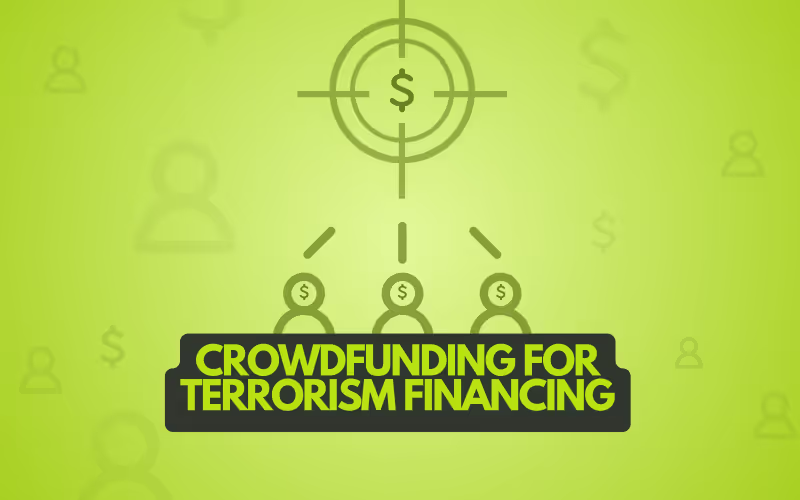
4 Examples of Illegal Crowdfunding for Terrorism Financing
The Financial Action Task Force (FATF) recently published a much-anticipated document, especially for the anti-money laundering (AML) and financial crime community: The 'Crowdfunding for Terrorism Financing' report. Within it are tangible and insightful case studies that shed light on how terrorist groups have harnessed crowdfunded methods for financing their activities. This sanctions.io article examines them - revealing must-read insights.
But before that, let's briefly examine the background of the report and look at the key takeaway.
The 2023 Crowdfunding for Terrorism Financing FATF Report: Key Takeaway
The FATF's Crowdfunding for Terrorism Financing report (click the link to read the full PDF), in a nutshell, is this: A comprehensive and updated 2023 document detailing terrorism financing (TF) strategies within the domain of crowdfunding.
Its release has been eagerly awaited. Why? Because it's an essential reference for AML and countering the financing of terrorism (CFT) professionals tirelessly working on managing the risks associated with TF via crowdfunding.
What Is Crowdfunding?
But what exactly does it mean to crowdfund for terrorist activities? As many of you know, crowdfunding - when done legally - involves the use of small amounts of capital from a large number of individuals to fund a business, project, or charity.
A key characteristic of crowdfunding is how fundraisers utilize offline and online networks to solicit funds. When done illegally, these funds are channeled to terrorist organizations and used to purchase weapons, train recruits, or support various aspects of their illegal operations.
In recent years, just like in lawful realms, illegal crowdfunding has significantly shifted to the highly connected online world.
FATF Research: 4 Ways Terrorist Financing Infiltrates Crowdfunding
One of the most crucial takeaways from the 2023 FATF Crowdfunding for Terrorism Financing report is the most common crowdfunding modus operandi terrorist organizations use.
Here they are:
- Through charitable causes
- Abusing dedicated crowdfunding platforms
- Utilizing social media sites and messaging apps
- Harnessing virtual assets
Spread out within the report's 64 pages (appearing as case-study boxes), all of the above methods are expanded upon with real-world examples. But don't worry - to save you from sifting through the lengthy document, sanctions.io has done it on your behalf.
The following section reveals the easy-to-grasp examples and the FATF's insights.
Case Study 1: Creating Fraudulent Charities
The first example comes under what the FATF describes as the abuse of humanitarian, charitable or non-profit causes. Put in simple terms, it means this: Individuals and terrorist organizations can hide behind the cover of non-profit causes for financial solicitation.
This issue is broader than terrorism financing. Far more well-known to the general population is how fraudsters create fake charities (often after natural disasters) and illicitly seek donations for personal gain. For example, in October 2023, the US's Internal Revenue Service (IRS) issued a news release warning people to be aware of fake charities.
As we already know, donating to a fake charity can cause more harm than just lining the pockets of criminals; it can also mean donors unknowingly contribute to the cash flow of terrorist organizations.
The FATF provided this case study: In 2013, an Australian national allegedly solicited funds through an unregistered and fraudulent charity claiming to be providing humanitarian aid to Syrian war refugees.
Donations via electronic transfers (to an Australian personal bank account) were requested on the fake charity's Facebook page. The bank closed the account after ISIL connections surfaced, and the individual publicly expressed support for the terrorist group (something the individual denied).
And to conclude, a key takeaway is this: Banks, FinTechs, and other financial institutions must continue to invest in the latest transaction screening technology that can detect suspicious patterns in both business and personal bank accounts.
Case Study 2: Abusing Dedicated Crowdfunding Platforms
Online crowdfunding platforms have proliferated worldwide over the last decade. And they mostly do a lot of good - from helping entrepreneurs raise funds for innovative products, allowing creatives to bring their artistic projects to life, to supporting charitable causes and community initiatives.
But the problem is this: These crowdfunding platforms and applications attract terrorist organizations like bees to a honey pot.
According to the FATF, there are two ways that funds make their way to nefarious actors:
- One time donations
- Subscription-based models
What is also highly concerning is the rise of non-mainstream crowdfunding platforms that welcome entities banned from mainstream ones for terms of service abuses. Law enforcement agencies engage in an ongoing cat-and-mouse game with these actors, shutting them down, only for them to reemerge in different forms.
The FATF provided this case study: In 2017, the 'Identitarian Movement Austria' (deemed a violent extremist group) allegedly used a now-defunct crowdsourcing platform called Wesearchr to raise EUR 1,500 for a campaign aimed to prevent asylum seekers from reaching Europe.
Case Study 3: Utilizing Social Media Platforms and Messaging Apps
There isn't a day in the news cycle when social media platforms and messaging apps don't appear in a story related to all kinds of financial crime. From money laundering to fraud and every type of scam imaginable, bad actors commit heinous crimes using the technology.
But how do terrorist organizations utilize it for crowdfunding purposes?
According to the FATF, it's straightforward to grasp: The success of the entire online crowdfunding platform industry (not just the illegal one) comes down to the eyeballs and clicks generated through successful social media campaigns. In recent years, terrorist groups have become apt at exploiting social media - such as by understanding the algorithms - to bring momentum to their illicit campaigns.
Regarding messaging apps, encryption features are utilized to commit actions such as sharing links and payment instructions.
The FATF provided this case study: In July 2023, Canadian law enforcement charged Khalilullah Yousuf with terrorism-related offenses. Yousuf is accused of spreading pro-ISIL propaganda on social media and conspiring to commit terrorist attacks. He is also charged with creating multiple fundraising campaigns on a crowdfunding platform.
Case Study 4: Harnessing Virtual Assets
The final example comes under what the report describes as the interaction of crowdfunding with virtual assets. According to the FATF, these are the most significant findings:
Bitcoin: Bitcoin is the most ubiquitous virtual asset used in crowdfunding for terrorism financing.
Privacy coins: Other types of virtual assets, such as privacy coins, are increasingly being observed.
Tumblers and mixers: Tumbler and mixer services are used to enhance transactional privacy, conceal identities, and hide the destination of the funds.
The FATF also states that virtual assets may not always be convenient for terrorist organizations. Why? Because they face the challenge of converting crowdfunded virtual assets into fiat currency.
The FATF provided this case study: In 2022, eight defendants received prison sentences after being found guilty of financing terrorism in France. French authorities found that EUR 250,000 from 63 donors was collected (both online and offline). These funds were used to purchase anonymous prepaid vouchers - and then subsequently used to buy virtual assets. These assets were ultimately withdrawn in cash in the conflict zone.
Closing Thoughts
Terrorist financing is a risk in every industry, but some industries pose higher risks than others. To learn more, the following sanctions.io article is recommended: High-Risk Industries for Money Laundering and Terrorist Financing.
This article looked closely at four crowdfunding methods of operations the FATF has identified as being used by terrorist organizations to fund their activities.
An essential facet of battling terrorist financing is for companies to have a robust AML/CFT and criminal watchlist screening program.
sanctions.io is an affordable AI-powered API solution with 99.99% uptime that companies use to screen their customers and business partners against sanctions, PEP, and criminal watchlists. To find out more about ways we can support your AML/CFT program, contact sanctions.io for an obligation-free discussion.
We also encourage you to take advantage of our free 7-day trial (no credit card is required).



